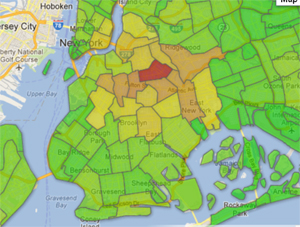Bed-Stuy wins Brooklyn’s rat race

Bedford-Stuyvesant is the unlucky New York City neighborhood where the most residents have picked up the phone and called 311 to report rats, according to a nifty interactive rat map put together by Gothamist.
Almost a thousand residents of Bed-Stuy’s Zip code 11221 (shown in dark brown on the map) complained about the furry pests, followed by Bed-Stuy’s 11216, with 626 sightings. Unfortunately, Zip code 11233 — also in Bed-Stuy — logged 568 complaints.
In September, a resident of Bedford-Stuyvesant (who wants to remain anonymous) told the Brooklyn Daily Eagle, “My roommates and I have a small cat, which caught a rat almost her size in the house. It wasn’t quite dead. One of my roommates had to take it outside and drop a brick on it and put it put of its misery.”